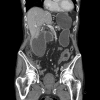Actinomyces infection causing acute right iliac fossa pain
- PMID: 24872493
- PMCID: PMC4039981
- DOI: 10.1136/bcr-2014-204559
Actinomyces infection causing acute right iliac fossa pain
Abstract
This is a case of a 75-year-old man being admitted to the on-call surgical department with acute abdominal pain. On arrival he was clinically dehydrated and shocked with localised pain over McBurney's point and examination findings were suggestive of appendiceal or other colonic pathology. Full blood testing revealed a white cell count of 38×10(9)/L and a C reactive protein (CRP) of 278 mg/L. A CT scan revealed a gallbladder empyema that extended into the right iliac fossa. This case highlights the potential for a hyperdistended gallbladder empyema to present as acute right iliac fossa pain with blood tests suggestive of complicated disease. Further analysis confirmed Actinomyces infection as the underlying aetiology prior to a laparoscopic subtotal cholecystectomy. This case serves to remind clinicians of this as a rare potential cause of atypical gallbladder pathology.
2014 BMJ Publishing Group Ltd.
Figures



References
-
- Esses D, Birnbaum A, Bijur P, et al. Ability of CT to alter decision making in elderly patients with acute abdominal pain. Am J Emerg Med 2004;22:270–2 - PubMed
-
- Lewis LM, Banet GA, Blanda M, et al. Etiology and clinical course of abdominal pain in senior patients: a prospective, multicenter study. J Gerontol A Biol Sci Med Sci 2005;60:1071–6 - PubMed
-
- Ormsby AH, Bauer TW, Hall GS. Actinomycosis of cholecystic duct:case report and review. Pathology 1998;30:65–7 - PubMed
-
- Fowler RC, Simpkins KC. Abdominal actinomycosis: a report of three cases. Clin Radiol 1983;34:301–7 - PubMed
Publication types
MeSH terms
Substances
LinkOut - more resources
Full Text Sources
Other Literature Sources
Medical
Research Materials
Miscellaneous
